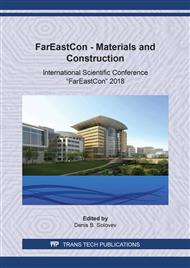[1]
YarullinA.F., Kusnetsova L.E., Yarullina A.F., Stoyanov O.V. Electrophysical properties of oligomer-polymer complexes based on heat-resistant oligoaryleneamines, Polymer science - series D. 6 No.2 (2013) 109-115.
DOI: 10.1134/s1995421213020172
Google Scholar
[2]
Bardella L., Genna F. On the elastic behavior of syntactic foams// International Journal of Solids and Structures. 38( 2001) 307-333.
DOI: 10.1016/s0020-7683(00)00228-6
Google Scholar
[3]
Skachkova V.K., Lyubimov А.V., Lyubimova G.V., Gusev М.N., Lalayan V.М., Shaulov А.Y, Berlin А.А. Optically transparent heat resistant nanocomposite materials on the basis of epoxy and silicon oxide, Russian nanotechnologies. 8(1-2) (2013) 82-86.
DOI: 10.1134/s199507801301014x
Google Scholar
[4]
Chukhlanov V.Y., Zhilin D.V., The study of the heat stabilizer impact on polydimethylsiloxane sealant dielectric properties, Aviation materials and technologies. 4 (2012) 56-59.
Google Scholar
[5]
Chukhlanov V. Yu., Kriushenko S. S., and Chukhlanova N. V. Elastic Polyurethane Foams Modified by Tetraethoxysilane, Theoretical Foundations of Chemical Engineering. 49 N.4 (2015) 518-522.
DOI: 10.1134/s0040579515040065
Google Scholar
[6]
Chukhlanov V. Yu., Selivanov O. G. Thermophysical properties of syntactic plastic foams based on polydimethylsiloxane binder, International Polymer Science and Technology. 43 N3 (2016) 39-41.
DOI: 10.1177/0307174x1604300308
Google Scholar
[7]
Wouterson E. M., Boey F. Y., Hu X., Wong S. C. Specific properties and fracture toughness of syntactic foam: Effect of foam microstructures// Composites Science and Technology. 65 (2005) 1840–1847.
DOI: 10.1016/j.compscitech.2005.03.012
Google Scholar
[8]
Nichlas T. Kamar, Mohammad Mynul Hossain, Anton Khomenko, Mahmood Haq, Lawrence T. Drzal, Alfred Loos. Interlaminar reinforcement of glass fiber/epoxy composites with grapheme nanoplatets, Сomposites Part A: Applied Science and Manufacturing. 70 (2015) 82-92.
DOI: 10.1016/j.compositesa.2014.12.010
Google Scholar
[9]
Anthony J., O'Lenick Jr. Silicone Polymers: New Possibilities in Nanotechnology, American Chemical Society. Symposium Series. 96 (2007) 165-175.
Google Scholar
[10]
Wouterson E. M., Boey F. Y., Hu X., Wong S. C. Specific properties and fracture toughness of syntactic foam: Effect of foam microstructures, Composites Science and Technology. 65 (2005) 1840–1847.
DOI: 10.1016/j.compscitech.2005.03.012
Google Scholar
[11]
Li Chen, Songgang Chai, Kai Liu, Nanying Ning, Jian Gao, Qianfa Liu, Feng Chen, and Qiang FuEnhanced Epoxy/Silica Composites Mechanical Properties by Introducing Graphene Oxide to the Interface // ACS Appl. Mater. Interfaces. 4 (8) (2012) 4398–4404.
DOI: 10.1021/am3010576
Google Scholar
[12]
Anthony J., O'Lenick Jr. Silicone Polymers: New Possibilities in Nanotechnology, American Chemical Society. – Symposium Series. 96 (2007) 165-175.
Google Scholar
[13]
Fried J.R. Polymers in Aerospace Applications Reviews. 16 № 12 (2008) 137-142.
Google Scholar
[14]
Chukhlanov V.Yu., Selivanov O.G. Electrical properties of syntactic foams based on hollow carbon microspheres and polydimethylsiloxane, Russian Physics Journal. 59 N7 (2016) 944–948.
DOI: 10.1007/s11182-016-0858-9
Google Scholar
[15]
Bell J., Lail D., Martin C., Nguyen P. Radiation Shielding for a Lunar Base, NASA report: National Aeronautics and Space Administration, 10 May. Washington. (2011).
Google Scholar
[16]
Yarmolenko M.A., Rogachev A.A., Rogachou A.V., Gorbochev D.L. Kinetic characteristics of dispersion of organosilicon compounds in vacuum and molecular structure of the coatings, deposited from volatile products of dispersion, Problems of Physics, Mathematics and Technics. 8 N3 (2011) 32–38.
DOI: 10.54341/20778708_2022_1_50_44
Google Scholar
[17]
Peters S.T. Handbook of Composites Hardcover – Springer; 2nd ed.: (1997).
Google Scholar
[18]
Yoonessi M., Lebrón-Colon M., Scheiman D. Meador M.A. Carbon Nanotube Epoxy Nanocomposites: The Effects of Interfacial Modifications on Dynamic Mechanical Properties of the Nanocomposite. ACS Appl. Mater. Interfaces, 6 (2014) 16621–16630.
DOI: 10.1021/am5056849
Google Scholar
[19]
Chukhlanov V.Yu., Selivanov O. G. and Chukhlanova N. V. A Sealing Composition with High Dielectric Characteristics and Increased Optical Transparency on the Basis of Epoxy Diane Resin Modified with Phenyl Ethoxysilane, Polym. Sci. D, 9 (2016) 281–285.
DOI: 10.1134/s1995421216030060
Google Scholar
[20]
Allaoui A., Bai S., Cheng H.M., Bai J.B. Mechanical and electrical properties of a MWNT/epoxy composite, Composites Science and Technology. 62 (2002) 1993–(1998).
DOI: 10.1016/s0266-3538(02)00129-x
Google Scholar


